
Bukhara is the seventh-largest city in Uzbekistan by population, with 280,187 residents as of 1 January 2020. It is the capital of Bukhara Region. The mother tongue of the majority of people of Bukhara is the Tajik dialect of the Persian language, although Uzbek is spoken as a second language by most residents.

Khiva is a district-level city of approximately 93,000 people in Khorazm Region, Uzbekistan. According to archaeological data, the city was established around 1500 years ago. It is the former capital of Khwarezmia, the Khanate of Khiva, and the Khorezm People's Soviet Republic. Itchan Kala in Khiva was the first site in Uzbekistan to be inscribed on the World Heritage List (1991). The astronomer, historian and polymath, Al-Biruni was born in either Khiva or the nearby city of Kath.

The Oka is a river in central Russia, the largest right tributary of the Volga. It flows through the regions of Oryol, Tula, Kaluga, Moscow, Ryazan, Vladimir and Nizhny Novgorod and is navigable over a large part of its total length, as far upstream as the town of Kaluga. Its length is 1,500 km (930 mi) and its catchment area 245,000 km2 (95,000 sq mi). The Russian capital Moscow sits on one of the Oka's tributaries—the Moskva.
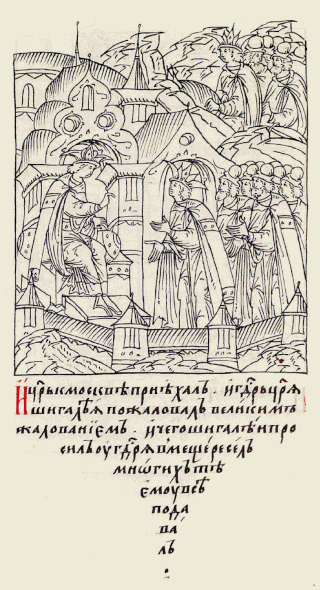
Shahghali, also Shah Ali or Shah Ghaly, (1505–1567) was khan of the Qasim Khanate and the Khanate of Kazan. He ruled the Qasim Khanate for much of his life and three times tried to rule the Khanate of Kazan, which was independent until its conquest by Muscovy in 1552. He also ruled the town of Kasimov as a vassal of the Russians. He was the son of the Qasim Khan Sheikh Auliyar and grandson of Bakhtiar Sultan, a brother of Ahmed Khan bin Küchük. One of his wives was the unfortunate Söyembikä of Kazan. He died childless in 1567 and was succeeded by Sain Bulat. He is described as physically repulsive and too fat to be a soldier, but a man of sound judgement. Shahghali was a direct descendant of Jochi Khan, the eldest son of Genghis Khan.

Kasimov is a town in Ryazan Oblast, Russia, located on the left bank of the Oka River. Population: 33,491 (2010 Census); 35,816 (2002 Census); 37,521 (1989 Census); 17,000 (1910).
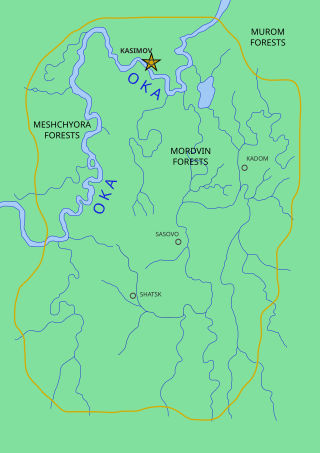
Qasim Khanate or Kingdom of Qasim or Khanate of Qasım was a Tatar-ruled khanate, a vassal of Russia, which existed from 1452 until 1681 in the territory of modern Ryazan Oblast in Russia with its capital at Kasimov, in the middle course of the Oka River. It was established in the lands which Grand Prince Vasily II of Moscow presented in 1452 to the Kazan prince Qasim Khan, son of the first Kazan khan Olug Moxammat.

The Huaisheng Mosque is the main mosque of Guangzhou. Rebuilt many times over its history, it is traditionally thought to have been originally built over 1,300 years ago, which would make it one of the oldest mosques in the world.

The Sunheri Mosque, also known as the Talai Mosque, is a late Mughal architecture-era mosque in the Walled City of Lahore, capital of the Pakistani province of Punjab.

Indo-Islamic architecture is the architecture of the Indian subcontinent produced by and for Islamic patrons and purposes. Despite an initial Arab presence in Sindh, the development of Indo-Islamic architecture began in earnest with the establishment of Delhi as the capital of the Ghurid dynasty in 1193. Succeeding the Ghurids was the Delhi Sultanate, a series of Central Asian dynasties that consolidated much of North India, and later the Mughal Empire by the 15th century. Both of these dynasties introduced Islamic architecture and art styles from West Asia into the Indian subcontinent.

Po-i-Kalan, or Poi Kalan, is an Islamic religious complex located in Bukhara, Uzbekistan. The complex consists of three parts, the Kalan Mosque, the Kalan Minaret to which the name refers, and the Mir-i-Arab Madrasah. The positioning of the three structures creates a square courtyard in its center, with the Mir-i-Arab and the Kalan Mosque standing on opposite ends. In addition, the square is enclosed by a bazaar and a set of baths connected to the Minaret on the northern and southern ends respectively.
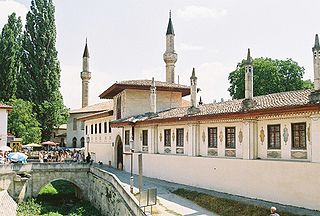
The Khan's Palace or Hansaray is located in the town of Bakhchysarai, Crimea. It was built in the 16th century and became home to a succession of Crimean Khans. The walled enclosure contains a mosque, a harem, a cemetery, living quarters and gardens. The palace interior has been decorated to appear lived in and reflects the traditional 16th-century Crimean Tatar style. It is one of the best known Muslim palaces found in Europe, alongside the Sultan palaces of Istanbul and the Alhambra in Spain.

The İske Taş or Iske Tash Mosque, also the Old Stone Mosque or the Mosque of the Old Stone, formerly known as The Ninth Cathedral Mosque, The Big Stone Mosque, is a mosque in Kazan, Russia.

A Tatar mosque is a mosque with a minaret on the roof, a type of mosque that is ubiquitous among Muslim Tatars and Bashkirs in Tatarstan and other Volga Tatar-populated areas. Occasionally found in other regions of Russia, modern Tatar religious architecture was developed in the late 18th century and gained popularity in the 19th century Idel-Ural.

The Downtown Candlemas Church of the Blessed Virgin Mary, formerly known as the Mosque of Pasha Qasim is a Roman Catholic church in Pécs, Hungary, which was a mosque in the 16–17th century due to the Ottoman conquest. It is one of the symbols of the city, located in the downtown, on the main square. The current building, a hundred steps in length and in width, was built by Pasha Qasim the Victorious between 1543 and 1546. The mosque was converted into a church in 1702, after Habsburg-Hungarian troops reconquered the city. The minaret was destroyed by the Jesuits in 1766. One of the largest Ottoman constructions remaining in Hungary, the building still retains many Turkish architectural characteristics.

The Bibi-Heybat Mosque is a historical mosque in Baku, Azerbaijan. The existing structure, built in the 1990s, is a recreation of the mosque with the same name built in the 13th century by Shirvanshah Farrukhzad II Ibn Ahsitan II, which was completely destroyed by the Bolsheviks in 1936.
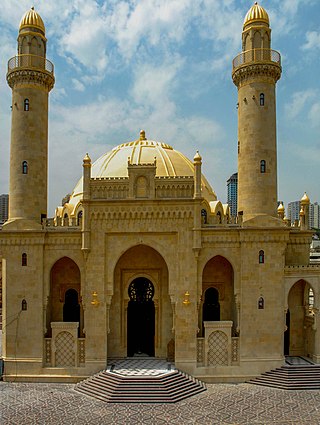
Taza Pir Mosque is a mosque in Baku, Azerbaijan. Its construction began in 1905 and was finished by 1914. The idea for the mosque as well as its financing was provided by an Azeri female philanthropist, Nabat Khanum Ashurbeyova (Ashurbeyli)
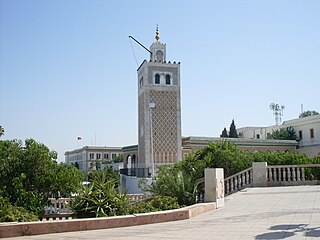
Kasbah Mosque is a mosque in Tunis, Tunisia. It is a listed as a Historical Monument.
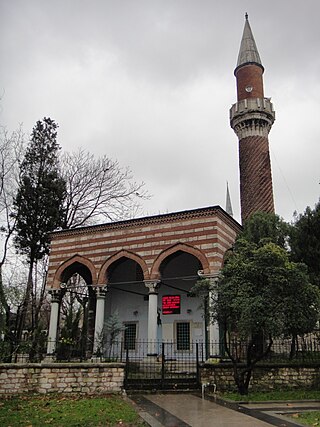
The Burmalı Mosque is a 16th-century Ottoman mosque in Şarachane park, Fatih district, Istanbul, Turkey.
İskender Pasha Mosque is a 16th-century built Ottoman mosque in Trabzon, Turkey.

The Yakovalı Hasan Paşa Mosque is an early 17th-century mosque in Pécs, southern Hungary. It was constructed when the region was part of the Turkish Ottoman Empire, together with the main mosque of Pécs, the Mosque of Pasha Qasim. It was named after the local government official who commissioned the mosque, Yakovalı Hasan Paşa, or Hasan Pasha of Yakova. It is thus one of the oldest mosques existing in Hungary today, and is considered to be the most intact mosque to have survived from the Ottoman era. The mosque is still active as a Muslim place of worship, and also houses a small exhibition centre for Turkish handicraft and historical artifacts documenting Hungary's Ottoman past.



















